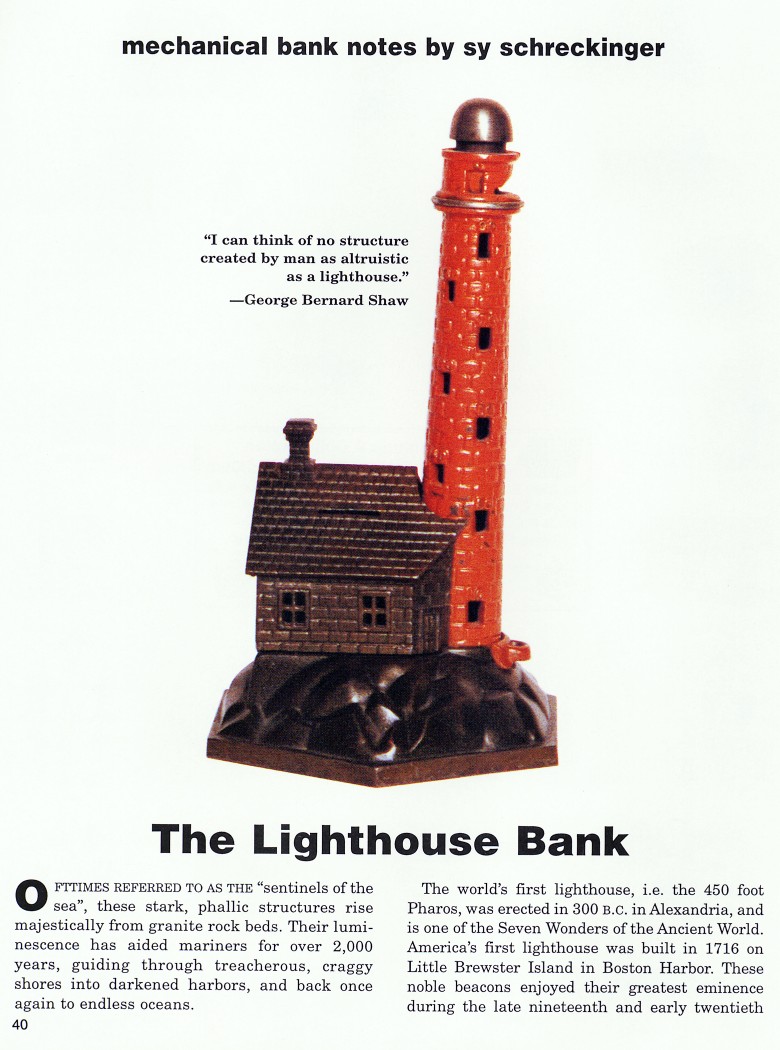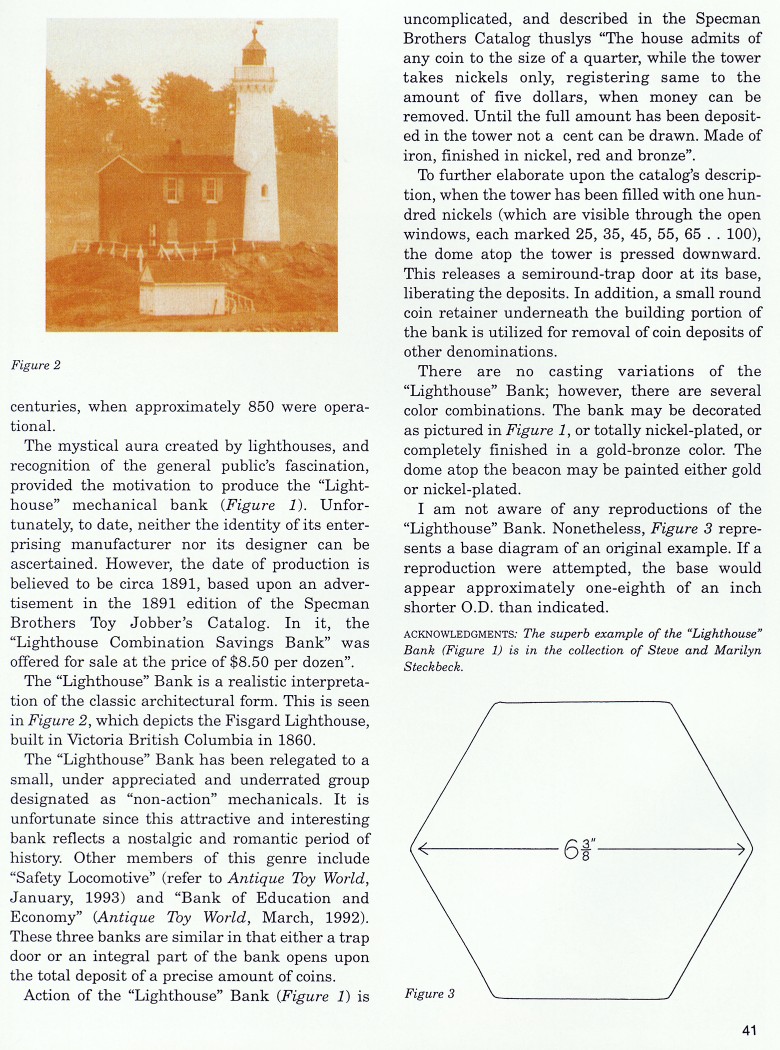|
The Lighthouse Bank
by Sy Schreckinger – ANTIQUE TOY WORLD Magazine – October, 1998
"I can think of no structure
created by man as altruistic
as a lighthouse"
— George Bernard Shaw
Ofttimes referred to as the "sentinels of the
sea", these stark, phallic structures rise majestically from granite rock
beds. Their luminescence has aided mariners for over 2,000 years, guiding
through treacherous, craggy shores into darkened harbors, and back once
again to endless oceans.
The world's first lighthouse, i.e. the 450 foot Pharos, was erected
in 300 B.C. in Alexandria, and is one of the Seven Wonders of the Ancient
World. America's first lighthouse was built in 1716 on Little Brewster
Island in Boston Harbor. These noble beacons enjoyed their greatest
eminence during the late nineteenth and early twentieth centuries, when
approximately 850 were operational.
The mystical aura created by lighthouses, and recognition of the
general public's fascination, provided the motivation to produce the
"Lighthouse" mechanical bank (Figure 1). Unfortunately, to date, neither
the identity of its enterprising manufacturer nor its designer can be
ascertained. However, the date of production is believed to be circa 1891,
based upon an advertisement in the 1891 edition of the Specman Brothers
Toy Jobber's Catalog. In it, the "Lighthouse Combination Savings Bank" was
offered for sale at the price of $8.50 per dozen".
The "Lighthouse" Bank is a realistic interpretation of the classic
architectural form. This is seen in Figure 2, which depicts the Fisgard
Lighthouse, built in Victoria British Columbia in 1860.
The "Lighthouse" Bank has been relegated to a small, under
appreciated and underrated group designated as "non-action" mechanicals.
It is unfortunate since this attractive and interesting bank reflects a
nostalgic and romantic period of history. Other members of this genre
include "Safety Locomotive" (refer to Antique Toy World,
January, 1993)
and "Bank of Education and Economy" (Antique Toy World,
March, 1992).
These three banks are similar in that either a trap door or an integral
part of the bank opens upon the total deposit of a precise amount of
coins.
Action of the "Lighthouse" Bank (Figure 1) is uncomplicated, and
described in the Specman Brothers Catalog thuslys "The house admits any
coin to the size of a quarter, while the tower takes nickels only,
registering same to the amount of five dollars, when money can be removed.
Until the full amount has been deposited in the tower not a cent can be
drawn. Made of iron, finished in nickel, red and bronze".
To further elaborate upon the catalog's description, when the tower
has been filled with one hundred nickels (which are visible through the
open windows, each marked 25, 35, 45, 55, 65 … 100), the dome atop the
tower is pressed downward. This releases a semiround-trap door at its
base, liberating the deposits. In addition, a small round coin retainer
underneath the building portion of the bank is utilized for removal of
coin deposits of other denominations.
There are no casting variations of the "Lighthouse" Bank; however,
there are several color combinations. The bank may be decorated as
pictured in Figure 1, or totally nickel-plated, or completely finished in
a gold-bronze color. The dome atop the beacon may be painted either gold
or nickel-plated.
I am not aware of any reproductions of the "Lighthouse" Bank.
Nonetheless, Figure 3 represents a base diagram of an original example. If
a reproduction were attempted, the base would appear approximately
one-eighth of an inch shorter O.D. than indicated.
ACKNOWLEDGMENTS: The superb example of the "Lighthouse" Bank (Figure
1) is in the collection of Steve and Marilyn Steckbeck.
Addendum: (from
January, 1999) Refer to Antique Toy World,
October, 1998,
"Lighthouse Bank". My thanks to fellow collector, Mr. Robert Seebold for
providing the following information: Only Liberty head type "V" nickels
will register the precise sum of deposits in the bank's tower. These coins
were first minted in 1883 and were discontinued in 1912. Subsequent
mintings of the Buffalo and Jefferson nickels proved much too thick to
stack correctly in the Lighthouse tower. This resulted in faulty
operation, and an inaccurate total coin count.
|

